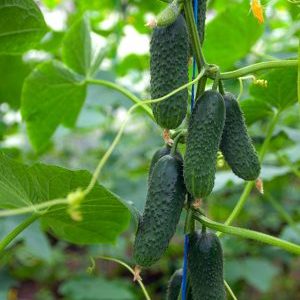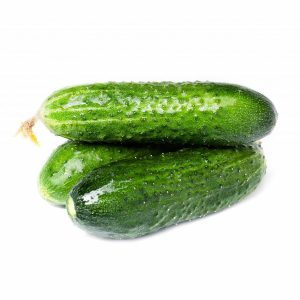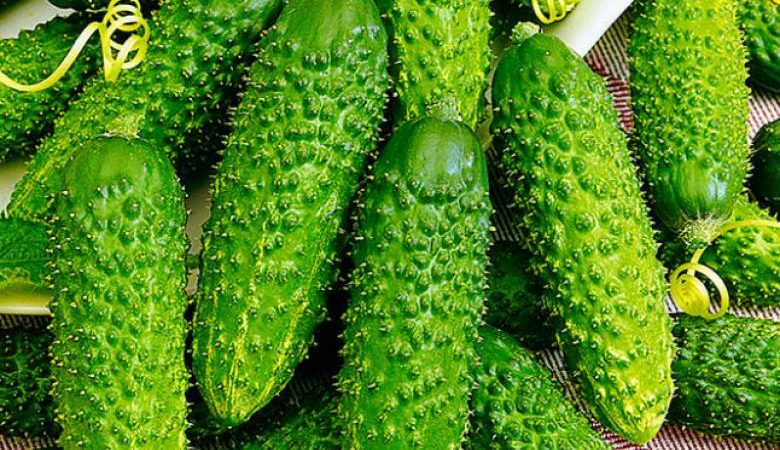What is good about the cucumber "Tumi" and why it should be grown on your site
What unites an experienced gardener and a city dweller who has never seen a garden in his life? Love for crispy and fresh cucumbers, without which the national Russian cuisine is unthinkable. In our time, the greenhouse hybrid Tumi is becoming more and more popular. Why did he deserve universal recognition?
The content of the article
Description
The Tumi cucumber is characterized by the characteristic of giving a rich early harvest, stable even in cool weather. The plant has compact internodes, each of which grows 2-3 fruits. Cucumber is easy to care for, resistant to disease and does not require frequent watering.
Tumi is a parthenocarpic hybrid, therefore it is marked with the “F1” marking.

Composition, properties and benefits
Tumi, like all cucumbers, is 97% water; 3% are useful elements.
It includes:
- potassium, which provides conduction in the nervous system;
- calcium is the main material for bones;
- phosphorus is part of the bone tissue;
- magnesium, sulfur, iron;
- vitamin B1, which plays an important role in a healthy metabolism;
- vitamin C, which strengthens the immune system;
- vitamin B2.
The calorie content of cucumbers is low, so this vegetable is considered an excellent dietary product for people prone to obesity.
Specifications
The bush grows to an average of 1.5 m and more. Side shoots grow quickly and actively, old shoots must be removed in a timely manner. The branching is average. Leaves are dark green, slightly wavy relief.
The average weight of the fruit is 120-150 g (sometimes 90-100 g). The type of fruit shape is gherkin - elongated, oval. The peel has a rich, dark green color. There are small whitish bumps that resemble thorns. Pubescence is weak or practically absent.
The pulp of the fruit is tender, crunchy, pleasant to the taste, without bitterness and with a pronounced aroma. The hybrid is versatile in use: it can be cut into salads, cooked pickled blanks and salting.
Productivity - about 9-20 kg of fruits from 1 m².
How to grow yourself
The place where cucumbers will grow is dug up in the fall. Already in early May, you can plant seeds in open ground. It is better to plant where tomatoes, potatoes, cabbage used to grow. For the beds, you need to choose a place in the shade with a temperature of about 27 ° C. The soil should be warm enough (about 16 ° C). The soil is fed with organic and mineral fertilizers (Agricola, Superphosphate).
To water you need to regularly to maintain the humidity level. It is impossible to loosen the soil, only manual weeding is permissible, since the roots of the cucumber do not go deep into the ground. You can plant it several times from early May to early June in case it gets colder again.
For Tumi cucumber, the seedling method is more suitable. The seedlings are grown in pots or paper cups, then the seedlings are transplanted into a greenhouse. You can plant the seeds of this hybrid already at the end of April, in order to move them into open ground by summer (for the autumn and spring turnover, the planting time is shifted).
A special mixture (peat, sawdust and mullein in a ratio of 3: 1: 0.5) diluted with water is poured into a container for planting. Then add some nitrogen, phosphorus, potassium and lime. It is not necessary to water the sprouts, since a sufficient level of humidity is already maintained (about 70%).
In 20-25 days after sowing, the sprouts are taken out to the greenhouse, by this time 3-4 leaves are already present on them. A few days before disembarkation, the seedlings are accustomed to the outside air, and a day feed mineral fertilizers.Fertilizers are washed off with clean water.
Attention! Suitable seedling density is 3 plants per 1 m².
Growing and care
Growing order:
- The seeds are sown at the end of April, at the end of May or at the beginning of June they are transferred to the greenhouse.
- When 3 full-fledged leaves are formed, the plant is given the first mineral feeding.
- It is regularly watered with settled warm water (cold water causes gray rot), but you should avoid moistening the soil above 90%.
- During the growing season, which for Tumi lasts 38-40 days, you need to feed the cucumbers with mineral fertilizers 2-3 times, alternating with organic ones.
A cucumber can grow in cool weather, but it does not tolerate temperature changes, therefore, the greenhouse is constantly maintained at about 25 ° C (when flowering - 27 ° C). If a crust appears on the ground, the soil is loosened to enrich the plant roots with oxygen and improve growth. Mulching is carried out with peat, straw, leaves and sawdust. This helps to protect the cucumbers from weeds and climatic influences.
Shoots that are formed above the first 3-4 leaves must be pinched so that the root system develops well. If the bush is growing actively, pinching is optional.
Watered with warm and settled water only at the root. The stem, leaves and fruits are sprayed with drip irrigation to prevent olive spot and bacteriosis. During periods of drought, you need to water more often - 1 time in 1-2 days. With a lack of moisture, the fruits become bitter.
"Nitrofoska" is suitable as top dressing. It improves seedling growth and tastes better.
Features of cultivation and possible difficulties
It is easy to grow this hybrid, even a beginner can cope with it. The main thing is to observe the regularity of watering, mulching, weeding and feeding. It is important to maintain a constant level of humidity and heat, and check plants for pests.
It is necessary to tie the plants to the trellises to give shape. Gardeners drive strong stakes 1.5-2 m long into the ground, pull a rope (twine) between them and tie up cucumber whips.
Attention! You will have to buy hybrid seeds every year.
Susceptibility to diseases and pests
Tumi is resistant to various diseases, in particular to brown spot (cladosporium).
It is important to inspect the plants periodically. Possible infection with cucumber mosaic virus, powdery mildew and vein yellowing virus. As a preventive measure, the greenhouse is ventilated once every 2 weeks and the doors and windows are washed with a disinfectant solution. Tumi is not resistant to white and gray rot, may suffer from whitefly.
Harvesting and application of the crop
Tumi gives a bountiful harvest 38 days after the first shoots appear. In use, this hybrid is versatile - it is eaten fresh, it is suitable for banquet cuts, thanks to its crispy skin, delicious pickles are obtained from it.
Advantages and disadvantages

Benefits:
- high commercial qualities and keeping quality;
- stable yield of the crop;
- high stress resistance;
- resistance to pests and diseases;
- powerful root system;
- long fruiting period;
- excellent taste;
- does not deteriorate in bad weather.
Disadvantages:
- instability to temperature surges;
- the need to tie up;
- you cannot get the seeds yourself.
Reviews
When describing varieties of cucumbers, gardeners pay attention to weather resistance and the taste of the fruit. Tumi gets good marks on these indicators.
Larisa, Volkhov: “We have a cool and not very sunny climate. The weather does not in any way affect the appearance of fruits and a huge number of shoots, the old ones of which must be removed. No insects are needed for pollination, it's convenient. "
Igor, Mozhaisk: “Tumi cucumber grows equally well in the greenhouse and in the open field. The fruits are large and beautiful, as in the photo on the package. Good taste - the pulp is juicy, dense and without bitter aftertaste. "
Conclusion
Cucumber Tumi is a well-known hybrid that is liked by many gardeners (both professionals and beginners), because you do not need to make a lot of effort to grow it, and the fruits surprise with excellent taste and versatility in use. This vegetable is a good choice for sun-poor regions. Unsurprisingly, many experienced gardeners recommend it for growing.